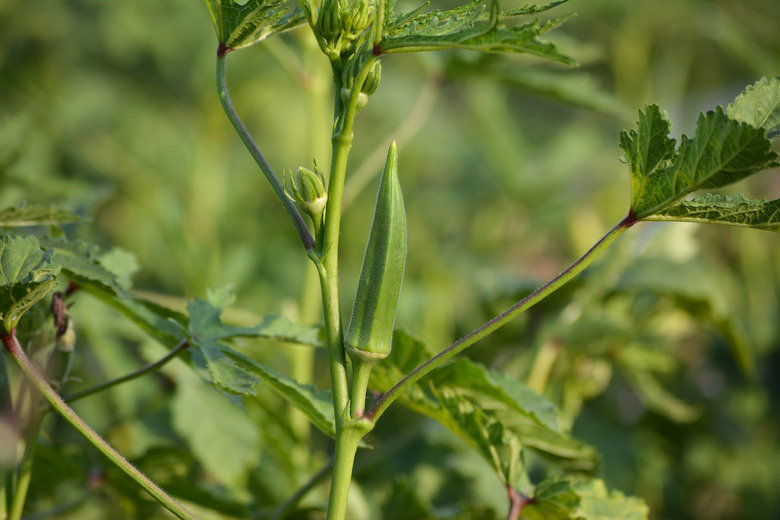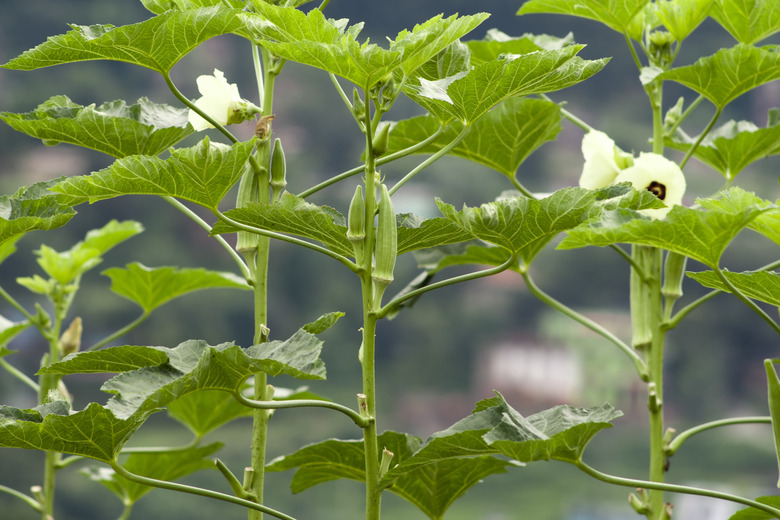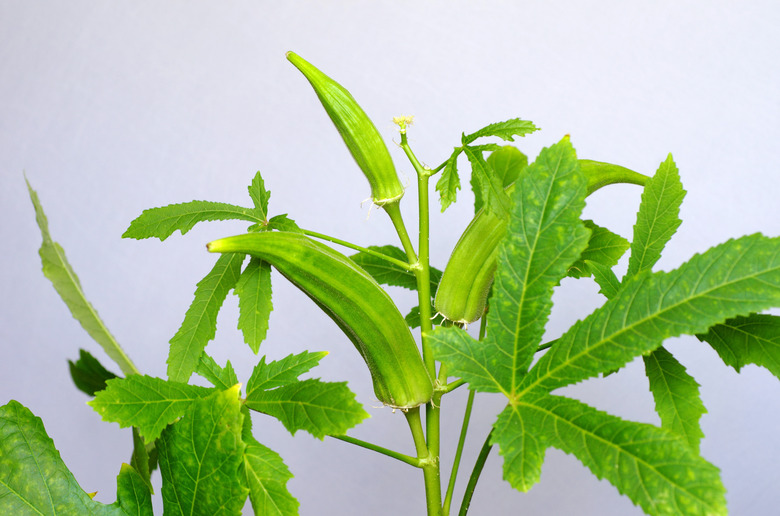How To Grow Okra
We may receive a commission on purchases made from links.
If you live in the South, you're probably more than familiar with okra (Abelmoschus esculentus). It's known as gumbo in the deep South because of the gooey consistency it develops when cooked, which makes it a good thickening agent, and it's a staple in the Southern diet. The word "gumbo" comes from West Africa, where the okra plant originated, and cooks there have used it for centuries, as have Native American people like the Choctaw who inhabited the South before the Europeans came.
Northerners may not be quite as familiar with okra because it's a warm-weather annual that thrives in southern climates, but gardeners in most parts of North America can grow it. It's a close relative of hibiscus, and when it matures, it sports a delicate yellowish-white flower with a purplish-red thorax highly reminiscent of the hibiscus flower. This, together with its tapering, cylindrical green and purple pods, which some people call lady fingers, make okra welcome in any vegetable garden or edible landscape. Some okra cultivars, such as Jing Orange, with its deep-red stems and pods, and Burgundy, are especially decorative.
The okra plant is an annual that grows 4 to 6 feet in height, and it has five-pointed, emerald-green leaves. About a month after planting, it starts to produce seed pods, and these take a few weeks to develop, although okra pods should be harvested when they are still quite young, or they become too hard to eat. The appearance of the delicate flowers is an indication that the pods will be ready in a few days.
Want to learn how to grow okra? Here's everything you need to know.
How to Grow Okra
How to Grow Okra
Starting Okra From Seed
In cold climates, you should start okra seeds indoors about three or four weeks before the last frost date, but in a more moderate climate with a longer growing season, it's easy to sow the large, round seeds directly in the ground two to three weeks after the frost date. When sowing outdoors in northerly regions, erecting a cold frame or mini greenhouse to protect the seedlings from cold weather is recommended. Make sure the structure is high enough to allow the plants to grow and leave it in place until the weather warms and you're sure the temperature won't fall below 60 degrees.
Okra seeds have a hard coating, and before you sow them, it's a good idea to soften this coating by soaking the seeds in water for 12 to 18 hours.
Here's how to plant okra seeds:
- Bury the seeds from 1/2 to 1 inch deep in containers or in rows in the garden.
- Space the seeds 12 to 18 inches apart and the rows 3 to 4 feet apart.
- If you plan to keep your okra plants in containers, make sure the containers are at least 10 inches deep.
Starting Okra From a Seedling
Okra doesn't like to have its roots disturbed, so if you purchase transplants, be sure they are in peat pots or some other type of compostable pots that will decompose. Here's how to plant okra seedlings:
- Prepare the soil by mixing in organic matter such as compost or aged manure to a depth between 6 and 10 inches.
- Thoroughly water the seedlings an hour before planting them and bury the stem about 1/2 inch deeper in the soil that is in the pot.
- Plant the seedlings in rows separated by 3 to 4 feet and space them 12 to 18 inches apart.
- Water the young plants regularly to keep the soil moist but hold off on adding mulch for a few days to give the sun a chance to warm up the soil.
- Once the plants are established, they'll need about an inch of water a week, but they are relatively drought-tolerant, and if water is an issue, they can survive on less.
In What Zone Does Okra Grow Best?
In What Zone Does Okra Grow Best?
Okra originated in the tropics, and it loves warm weather, so it grows best in USDA zones 7 to 10, where summers are long and hot. In cooler zones, it will flourish as long as it has six to eight hours of sunlight a day, and the growing season is at least 60 days long, which applies to most parts of the United States. The only disadvantage of growing okra in a cold climate is that you may not have time to prune back the plants and let them regrow to produce a second harvest.
Where to Plant Okra
Where to Plant Okra
Okra is a large plant and is best grown by itself in any part of the garden that receives full sun. When sharing a vegetable or flower garden with other plants, okra should be at the back and out of the line of the sun to avoid shading other plants. Okra will grow alongside most other vegetables, but the best companion plants for okra are melons, cucumbers, sweet peppers, and eggplant, and since none of these reach the same height, they can occupy the space in front of or between your okra plants as long as they also get the sunlight they need.
Once harvest starts, you'll be pulling pods from the plant every few days, so you want to make sure the plants are accessible and that you don't have to tramp through a field of ripening melons to get to them. This is one reason growing okra on its own is a good idea, and another is to highlight the okra flowers, which are quite showy when they bloom. An okra garden in the corner of the yard or as a border creates a feast for the eyes during the flowering season.
When Should You Plant Okra?
When Should You Plant Okra?
Okra should be planted in early spring, and the sooner you can plant it after the last frost date, the better because you can tease more than one harvest from the plant if it has long enough to grow. Do not sow seeds if the soil temperature is below 65 degrees, or if there's danger of another frost because the cold will kill them. In some regions, it's best to wait until June to plant seedlings, which means starting the seeds in mid to late April.
Soil, Sunlight, and Water Recommendations for Okra
Soil, Sunlight, and Water Recommendations for Okra
Okra grows best in well-draining soil, but of course, it does better when the soil has all the nutrients it needs in abundance. That's why it's important to amend the soil with organic matter like compost and aged manure before planting, but failing that, fertilize according to the results of a soil test.
In the absence of a test, broadcast 2 to 3 pounds of 10-10-10 or 15-5-10 fertilizer per 100 square feet of garden space. Soil should be slightly acidic with a pH between 5.8 and 7.0. Yearly crop rotation is recommended to avoid soil-borne fungal diseases.
Perhaps more than any other summer crop, okra needs to be in full sun, and even a small amount of shade can stunt growth or cause the seed pods to rot. The okra plant appreciates regular watering and should get an inch every week, but it's moderately drought-tolerant and probably won't die off if the soil dries out. To be on the safe side, apply mulch to retain moisture in dry climates.
How to Propagate Okra
How to Propagate Okra
The usual way to propagate okra is from seeds obtained from seed pods that are left to mature and harden. Before sowing the seeds, soak them overnight in plain water. Some gardeners suggest rubbing the seed cases on a file or sandpaper to soften the coating before sowing them.
When to Harvest Okra
When to Harvest Okra
The best time to harvest okra pods is three or four days after the flowers drop, which ensures they are young and tender enough to eat. If you wait much longer than that, the pods become tough, and while you can still use them for cooking, they won't be as flavorful.
One of the problems you'll encounter when harvesting okra is the tiny spines that line the outsides of the seed pods, which are definitely irritating and may even cause an allergic reaction for some people. You can avoid this by planting a spineless cultivar, such as Clemson spineless or Annie Oakley, but if you planted another cultivar, it's best to wear gloves and a shirt with long sleeves while you harvest okra.
Tip
If you live in a warm area with a long growing season, you can get a double harvest by ratooning, which means pruning back the plants to 6 inches or so above ground level, generally in mid-summer, and letting them regrow.
Common Pests and Other Problems for Okra
Common Pests and Other Problems for Okra
Like most other plants, okra can have pest issues. Here are some common pests for the okra plant:
- Aphids: These bugs are problematic for okra plants as they are for most leafy vegetables. They congregate on the undersides of the leaves and produce honeydew, a sticky substance that can promote sooty mold growth if left long enough. Honeydew also attracts ants, but that doesn't matter unless they're fire ants, which can damage the flowers. Remove aphids by spraying down the plants with water in the early morning or late evening when the sun won't scorch the wet leaves.
- Stink bugs: Another common pest, stink bugs burrow into the pods, leaving behind a deformed or curved pod instead of a straight one. You can pick off the ones you see and leave the rest to the birds, but if you have a persistent problem, consider deploying a stink bug trap to catch them.
- Root-knot nematodes: These are microscopic parasitic worms that live in the soil, and they are a particular problem for okra because they thrive in the same warm conditions as okra. They cause irregular plant growth and yellowing leaves, but the damage they do is particularly visible on the roots, which are eventually destroyed. They don't move far in the soil, so crop rotation is the best way to prevent future infestations.
Common Diseases for Okra
Common Diseases for Okra
The most common diseases affecting okra are fungi that thrive when the soil is cool and moist. Chief among these is fusarium wilt, which causes leaf wilt, stunts plant growth and ultimately kills the plant. Related diseases include charcoal rot, which affects the stems first and then the leaves; southern blight, which causes the branches to turn brown and leaves a mycelial web on the leaves; and powdery mildew, which produces a fine white residue on the leaves.


